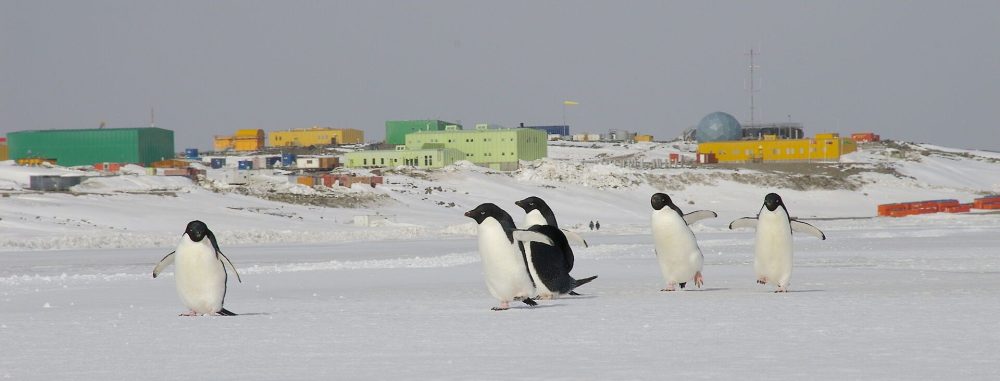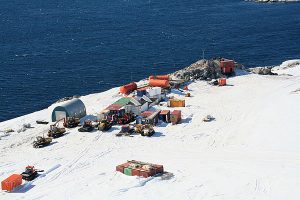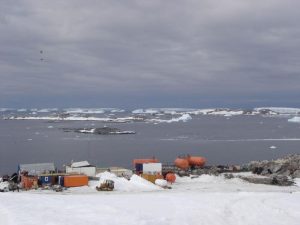 |
 Robert Guillard-Cap Prud’homme Station at 66°41’31″South, 139°53’46″East, is a French-Italian station managed by the French Polar Institute Paul-Emile Victor (IPEV) and the Programma Nazionale di Ricerche in Antartide (PNRA).
Robert Guillard-Cap Prud’homme Station at 66°41’31″South, 139°53’46″East, is a French-Italian station managed by the French Polar Institute Paul-Emile Victor (IPEV) and the Programma Nazionale di Ricerche in Antartide (PNRA).
This small Base that serving as a relay point for crossings to the Concordia Station (WAP MNB-Ø3) was established in the early 1990’s in Antarctica, close to the sea and at about 5 km far from Dumont d’Urville Station (WAP FRA-Ø1). It is the point of departure of the traverses to Concordia station. There is no ice free area around the station nor protected area in the immediate vicinity, as well as no fauna and flora. The Station is built on a rock near the coast but its surroundings are entirely covered by ice or snow.
 The joint French-Italian Station Robert Guillard-Cape Prud’homme (WAP MNB-NEW) forms an integral part of the Concordia project. It offers a gateway to Concordia for the transport of heavy tools and equipment, following delivery by the resupply vessel L’Astrolabe to Dumont d’Urville Station. In this context, and because Dumont d’Urville station is not on the continent itself, Cap Prud’homme was established for the development and maintenance of the traverse equipment (tractors, trailers, accommodation caravans), its winter storage, and preparation of transport convoys. The site was selected because it was used from 1955 as Antarctica Gateway for French expeditions.
The joint French-Italian Station Robert Guillard-Cape Prud’homme (WAP MNB-NEW) forms an integral part of the Concordia project. It offers a gateway to Concordia for the transport of heavy tools and equipment, following delivery by the resupply vessel L’Astrolabe to Dumont d’Urville Station. In this context, and because Dumont d’Urville station is not on the continent itself, Cap Prud’homme was established for the development and maintenance of the traverse equipment (tractors, trailers, accommodation caravans), its winter storage, and preparation of transport convoys. The site was selected because it was used from 1955 as Antarctica Gateway for French expeditions.
Few scientific activities are conducted at Cap Prud’homme Station, except some glaciological studies of the Astrolabe Glacier. Since 2012, scientific traverses have been developed for pure scientific purposes.
he station is open in summer only. The staff is mainly composed of technicians working on the maintenance of the traverse equipment, as well as drivers in charge of the 3 convoys per year.
Access to Cap Prud’homme Station is mainly by ship (L’Astrolabe) via Dumont d’Urville Station. A runway on snow allows landing of small aircrafts (Twin Otter or Basler) for the links between Concordia (WAP MNB-Ø3)and the Italian Station Mario Zucchelli (WAP ITA-Ø1).

Station Robert Guillard-Cap Prud’homme à 66°41’31″Sud, 139°53’46″Est, est une station franco-italienne géré par l’Institut Polaire Français Paul-Emile Victor (IPEV) et le Programma Nazionale di Ricerche à Antartide (PNRA).
Cette petite Base qui sert de point relais pour les traversées vers la Gare Concordia (WAP MNB-Ø3< /span>) a été établi au début des années 1990 en Antarctique, près de la mer et à environ 5 km de la Station Dumont d’Urville (< strong>WAP FRA-Ø1). C’est le point de départ des traversées vers la gare Concordia. Il n’y a pas de zone libre de glace autour de la station ni de zone protégée à proximité immédiate, ainsi qu’aucune faune et flore. La Station est construite sur un rocher près de la côte mais ses environs sont entièrement recouverts de glace ou de neige.

Les formulaires conjoints Station franco-italienne Robert Guillard-Cap Prud’homme (WAP MNB-NEW) partie intégrante du projet Concordia. Il offre une porte d’entrée vers Concordia pour le transport d’outillages lourds et d’équipements, après livraison par le navire de ravitaillement L’Astrolabe à la station Dumont d’Urville. Dans ce contexte, et parce que la gare Dumont d’Urville n’est pas sur le continent, Cap Prud’homme a été créé pour l’aménagement et l’entretien du matériel de traverse (tracteurs, remorques, caravanes d’hébergement), son hivernage, et la préparation des transports convois. Le site a été choisi car il a été utilisé à partir de 1955 comme porte d’entrée de l’Antarctique pour les expéditions françaises.
Peu d’activités scientifiques sont menées à la Station Cap Prud’homme, à l’exception de quelques études glaciologiques du Glacier de l’Astrolabe. Depuis 2012, des traverses scientifiques sont développées à des fins purement scientifiques.
la station est ouverte uniquement en été. Le personnel est principalement composé de techniciens travaillant sur la maintenance du matériel de traverse, ainsi que de chauffeurs en charge des 3 convois par an.
L’accès à la station Cap Prud’homme se fait principalement par bateau (L’Astrolabe) via la station Dumont d’Urville. Une piste sur neige permet l’atterrissage de petits aéronefs (Twin Otter ou Basler) pour les liaisons entre Concordia (WAP MNB-Ø3) et la gare italienne Mario Zucchelli (WAP ITA-Ø1).
Info de la Source Publié * ICI
